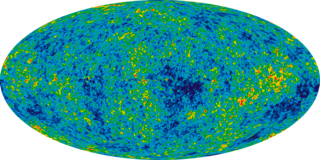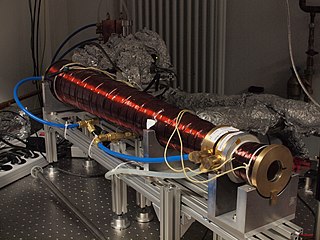In physics, the cross section is a measure of the probability that a specific process will take place in a collision of two particles. For example, the Rutherford cross-section is a measure of probability that an alpha particle will be deflected by a given angle during an interaction with an atomic nucleus. Cross section is typically denoted σ (sigma) and is expressed in units of area, more specifically in barns. In a way, it can be thought of as the size of the object that the excitation must hit in order for the process to occur, but more exactly, it is a parameter of a stochastic process.
The Doppler effect is the change in the frequency of a wave in relation to an observer who is moving relative to the source of the wave. The Doppler effect is named after the physicist Christian Doppler, who described the phenomenon in 1842. A common example of Doppler shift is the change of pitch heard when a vehicle sounding a horn approaches and recedes from an observer. Compared to the emitted frequency, the received frequency is higher during the approach, identical at the instant of passing by, and lower during the recession.

In physics and general relativity, gravitational redshift is the phenomenon that electromagnetic waves or photons travelling out of a gravitational well lose energy. This loss of energy corresponds to a decrease in the wave frequency and increase in the wavelength, known more generally as a redshift. The opposite effect, in which photons gain energy when travelling into a gravitational well, is known as a gravitational blueshift. The effect was first described by Einstein in 1907, eight years before his publication of the full theory of relativity.

In physics, interference is a phenomenon in which two coherent waves are combined by adding their intensities or displacements with due consideration for their phase difference. The resultant wave may have greater intensity or lower amplitude if the two waves are in phase or out of phase, respectively. Interference effects can be observed with all types of waves, for example, light, radio, acoustic, surface water waves, gravity waves, or matter waves as well as in loudspeakers as electrical waves.
Flow measurement is the quantification of bulk fluid movement. Flow can be measured using devices called flowmeters in various ways. The common types of flowmeters with industrial applications are listed below:

A sine wave, sinusoidal wave, or sinusoid is a periodic wave whose waveform (shape) is the trigonometric sine function. In mechanics, as a linear motion over time, this is simple harmonic motion; as rotation, it corresponds to uniform circular motion. Sine waves occur often in physics, including wind waves, sound waves, and light waves, such as monochromatic radiation. In engineering, signal processing, and mathematics, Fourier analysis decomposes general functions into a sum of sine waves of various frequencies, relative phases, and magnitudes.

Time of flight (ToF) is the measurement of the time taken by an object, particle or wave to travel a distance through a medium. This information can then be used to measure velocity or path length, or as a way to learn about the particle or medium's properties. The traveling object may be detected directly or indirectly. Time of flight technology has found valuable applications in the monitoring and characterization of material and biomaterials, hydrogels included.

A beam splitter or beamsplitter is an optical device that splits a beam of light into a transmitted and a reflected beam. It is a crucial part of many optical experimental and measurement systems, such as interferometers, also finding widespread application in fibre optic telecommunications.

Laser Doppler velocimetry, also known as laser Doppler anemometry, is the technique of using the Doppler shift in a laser beam to measure the velocity in transparent or semi-transparent fluid flows or the linear or vibratory motion of opaque, reflecting surfaces. The measurement with laser Doppler anemometry is absolute and linear with velocity and requires no pre-calibration.

A pulse-Doppler radar is a radar system that determines the range to a target using pulse-timing techniques, and uses the Doppler effect of the returned signal to determine the target object's velocity. It combines the features of pulse radars and continuous-wave radars, which were formerly separate due to the complexity of the electronics.

Continuous-wave radar is a type of radar system where a known stable frequency continuous wave radio energy is transmitted and then received from any reflecting objects. Individual objects can be detected using the Doppler effect, which causes the received signal to have a different frequency from the transmitted signal, allowing it to be detected by filtering out the transmitted frequency.

The Sagnac effect, also called Sagnac interference, named after French physicist Georges Sagnac, is a phenomenon encountered in interferometry that is elicited by rotation. The Sagnac effect manifests itself in a setup called a ring interferometer or Sagnac interferometer. A beam of light is split and the two beams are made to follow the same path but in opposite directions. On return to the point of entry the two light beams are allowed to exit the ring and undergo interference. The relative phases of the two exiting beams, and thus the position of the interference fringes, are shifted according to the angular velocity of the apparatus. In other words, when the interferometer is at rest with respect to a nonrotating frame, the light takes the same amount of time to traverse the ring in either direction. However, when the interferometer system is spun, one beam of light has a longer path to travel than the other in order to complete one circuit of the mechanical frame, and so takes longer, resulting in a phase difference between the two beams. Georges Sagnac set up this experiment in 1913 in an attempt to prove the existence of the aether that Einstein's theory of special relativity makes superfluous.

Ring lasers are composed of two beams of light of the same polarization traveling in opposite directions ("counter-rotating") in a closed loop.

Acousto-optics is a branch of physics that studies the interactions between sound waves and light waves, especially the diffraction of laser light by ultrasound through an ultrasonic grating.
Electrophoretic light scattering is based on dynamic light scattering. The frequency shift or phase shift of an incident laser beam depends on the dispersed particles mobility. With dynamic light scattering, Brownian motion causes particle motion. With electrophoretic light scattering, oscillating electric field performs this function.
The photoacoustic Doppler effect is a type of Doppler effect that occurs when an intensity modulated light wave induces a photoacoustic wave on moving particles with a specific frequency. The observed frequency shift is a good indicator of the velocity of the illuminated moving particles. A potential biomedical application is measuring blood flow.
Photon Doppler velocimetry (PDV) is a one-dimensional Fourier transform analysis of a heterodyne laser interferometry, used in the shock physics community to measure velocities in dynamic experiments with high temporal precision. PDV was developed at Lawrence Livermore National Laboratory by Oliver Strand. In recent years PDV has achieved popularity in the shock physics community as an adjunct or replacement for velocity interferometer system for any reflector (VISAR), another time-resolved velocity interferometry system. Modern data acquisition technology and off-the-shelf optical telecommunications devices now enable the assembly of PDV systems within reasonable budgets.

In atomic physics, a Zeeman slower is a scientific instrument that is commonly used in atomic physics to slow and cool a beam of hot atoms to speeds of several meters per second and temperatures below a kelvin. The gas-phase atoms used in atomic physics are often generated in an oven by heating a solid or liquid atomic sample to temperatures where the vapor pressure is high enough that a substantial number of atoms are in the gas phase. These atoms effuse out of a hole in the oven with average speeds on the order of hundreds of m/s and large velocity distributions. The Zeeman slower is attached close to where the hot atoms exit the oven and are used to slow them to less than 10 m/s (slowing) with a very small velocity spread (cooling).
Saturated absorption spectroscopy measures the transition frequency of an atom or molecule between its ground state and an excited state. In saturated absorption spectroscopy, two counter-propagating, overlapped laser beams are sent through a sample of atomic gas. One of the beams stimulates photon emission in excited atoms or molecules when the laser's frequency matches the transition frequency. By changing the laser frequency until these extra photons appear, one can find the exact transition frequency. This method enables precise measurements at room temperature because it is insensitive to doppler broadening. Absorption spectroscopy measures the doppler-broadened transition, so the atoms must be cooled to millikelvin temperatures to achieve the same sensitivity as saturated absorption spectroscopy.
Polarization gradient cooling is a technique in laser cooling of atoms. It was proposed to explain the experimental observation of cooling below the doppler limit. Shortly after the theory was introduced experiments were performed that verified the theoretical predictions. While Doppler cooling allows atoms to be cooled to hundreds of microkelvin, PG cooling allows atoms to be cooled to a few microkelvin or less.



























